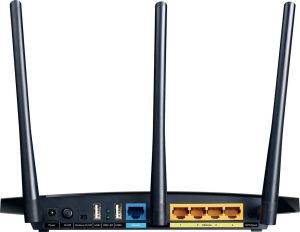TP-Link TL-WDR4300
From DD-WRT Wiki
Place holder for TP-Link TL-WDR4300, please add useful infos!
TL-WDR4300 hardware info
| CPU | Atheros AR9344 |
|---|---|
| CPU Speed | 560 MHz |
| Flash ROM | 8 MB |
| RAM | 128 MB |
| Radios | 1x 2.4 GHz / 1x 5Ghz |
| WLAN Support | A/B/G/N |
| WLAN Max Speed | 300mbps on 2.4Ghz and 450mpbs on 5Ghz |
| Antenna Location | 3x removable external |
| Switch | 4x Gigabit ethernet + 1 Gigabit ethernet WAN |
| USB | 2x USB 2.0 |
Multiple VLAN and SSID Configuration
To properly configure multiple Bridges and multiple VLANs it's necessary to get the Interfaces names and Port IDs right. The confusing thing is that there are three different naming schemes present:
- 1st the printed labels on the chassis
- 2nd the labels used in the web frontend
- 3rd the names used on the CLI
Since most of the Layer 2 (switching and bridging) features are only configurable through the CLI the Diagram and the following descriptions refer to the names used in the CLI. Once configured properly though the CLI the names appear in the WEB frontend as well.
The 4300 has a powerful 5 Port Switch which is capable to use the ports in Tagged Mode (802.1Q) as well as Port Based VLAN mode. Even mixed Mode is possible.
The default configuration as seen in the diagram shows the following interfaces:
- ath0
- the radio for 2,4 GHz - is not used as layer 3 interface (has no ip-address).
- ath1
- the radio for 5 GHz - is not used as layer 3 interface (has no ip-address).
- eth0
- the interface on which the switch is connected - is not used as layer 3 interface (has no ip-address).
- vlan1
- the logical interface that represents the LAN - is not used as layer 3 interface (has no ip-address).
- vlan2
- the logical interface that represents the WAN
- br0
- the logical interface for the complete LAN. This is the interface has the LAN-IP-Address.
How to replace OpenWrt with DD-WRT
- Set up an HTTP server.
- Download the firmware file "/tplink_tl-wdr4300v1/factory-to-ddwrt.bin" from the build folder, and save the firmware file to the root of the public web server folder. You must use the "factory-to-ddwrt.bin" file when writing with
mtd. Do not use the "tl-wdr4300-webflash.bin" file, which will brick your router. - Login by SSH.
- View the partitions.
-
cat /proc/mtd
-
- Verify that you have a "firmware" partition for
mtdto write. - You must download the firmware file in the "/tmp" directory.
-
cd /tmp -
wget http://192.168.1.100/factory-to-ddwrt.bin
-
- Write the firmware.
-
mtd -r write /tmp/factory-to-ddwrt.bin firmware
-


